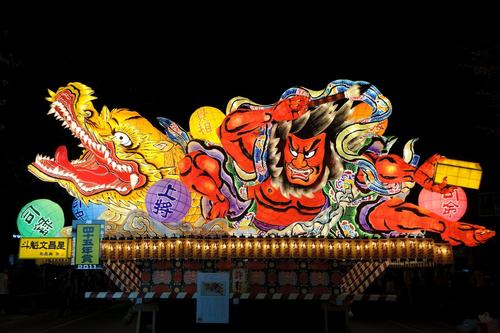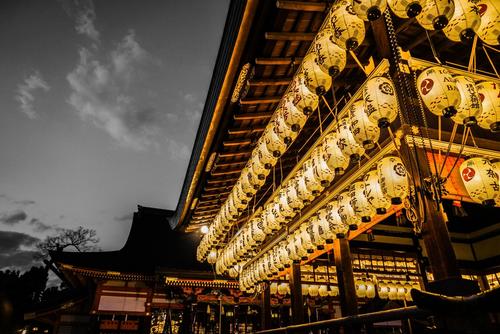All over Japan, various festivals are held based on local customs. The unique atmosphere of festivals, with things like grilled squid and candy apples from food stalls, goldfish scooping, fireworks, carrying portable shrines, and dancing, is truly summer-like.
However, when we look at the origins of why festivals are held, it seems that even among Japanese people there are few who fully understand the reason.
So this time, we will be explaining about Japanese festivals, including the three major festivals in Japan.
What are Japanese festivals?

Many people today think of festivals in Japan as a time to eat delicious food and watch fireworks, but long ago they were sacred events to worship the gods.
It is believed that the festival in Japan began in the ancient myth of "Iwatogakure."
The Hidden Rock Cave is a story about how the sun goddess Amaterasu Omikami hid herself in the Heavenly Rock Cave, causing the entire country to lose light, and the eight million gods, trying to do something about it, held a grand party in front of the cave, dancing and singing.
The eight million gods held a grand banquet in front of the cave in an attempt to attract the attention of Amaterasu Omikami, who had hidden herself inside, and get her to come out. As a result, Amaterasu Omikami finally emerged from the cave, and light returned to the land.
It is said that this "banquet" is the origin of today's festivals.
The word "matsuri" (festival) is derived from the verb "matsuru" (to worship), which also has the meaning of offering food to the gods.
In this way, it is believed that the gods are deeply connected to the origins of Japanese festivals.
Since then, festivals have been held in Japan to express gratitude to the gods and to deliver prayers.
In ancient times, festivals were always closely connected to people's lives, with people praying for good harvests and peace, and for disasters to be warded off when they struck.
By the time the Edo period began, festivals had become more "entertainment-oriented" and, with flashy performances such as portable shrines, lion dances, and fireworks, they had become established as popular culture, especially among the common people.
Festivals were banned for a time by the "Buddhist and Shinto Separation Order" issued during the Meiji period, but after the war, there was a growing movement to revive Japanese festivals, and since then festivals have been held as if they had returned to the Edo period.
Japanese festivals have gradually evolved from religious ceremonies to prayers to entertainment, but the most distinctive feature of Japanese festivals is their diversity. It's fascinating how the events and symbols held at festivals vary greatly from region to region, with Kanto lanterns and Namahage in the Tohoku region, Awa Odori in Shikoku, and Eisa in Okinawa.
Japan's festivals are diverse, but there are some things that are common throughout the country.
That is the existence of the "mikoshi."
It is no exaggeration to say that mikoshi, which are thought to be "carried by gods," are a traditional culture that can be seen consistently throughout Japan's diverse festivals.
Consistency found amidst diversity...the more you learn about the history of Japanese festivals, the more fascinating it becomes, doesn't it?
What are Japan's three major festivals?

Various festivals are held all over the country, but among them, the Gion Festival in Kyoto, the Tenjin Festival in Osaka, and the Kanda Festival in Tokyo are the three largest festivals with a long history and are known as the three major festivals representing Japan.
Let's take a closer look below.
Gion Festival (Yasaka Shrine, Kyoto City)
The Gion Festival has been held since the reign of Emperor Seiwa in 869, making it a historic festival with over 1,100 years of history.
The festival takes place over the course of a month, from July 1st to 31st, with an unprecedented number of events taking place on different dates.
The Gion Festival is packed with countless events, including the "Kichifuiri" ceremony to pray for the safety of the event, the Nagatoboko practice and demonstration, the parade around Yasaka Shrine, the purification of the portable shrine, the unveiling of family heirloom folding screens, the biennial service by the Omotesenke and Urasenke schools, Iwami Kagura, and more!
However, since it lasts for a month, it is quite difficult to attend all the events.
In such cases, it might be a good idea to visit the Gion Festival and pay attention to the "Maematsuri" and "Atomatsuri," which are the highlights of the festival.
The first festival is larger in scale, so it is recommended for those who want to enjoy the Gion Festival to the fullest.
Tenjin Festival (Osaka Tenmangu Shrine, Osaka City)
The Tenjin Festival, which takes place over two days on July 24th and 25th, is a historic festival that has been held since the mid-Heian period.
The highlight of the festival is the Honmiya Funatogyo on the 25th, with many people flocking to watch the procession, which begins around 6pm.
The sight of a fleet of over 100 boats, led by the Gohorensen boat carrying the divine spirit of Sugawara no Michizane, traveling up and down the Okawa River is truly spectacular, and approximately 5,000 fireworks are launched high into the sky.
Additionally, the Tenjin Festival's unique dance, the "Dragon Dance," depicts a dragon rising to the heavens to the rhythm of the lively danjiri bayashi music.
Also known as the "Snake Dance," this dance is attracting attention as it can only be seen at the Tenjin Festival.
Kanda Festival (Kanda Shrine, Tokyo)
The Kanda Festival, held at Kanda Shrine, is held every two years in mid-May.
The origins of the Kanda Festival are unknown as there are almost no records remaining, but we do know that during the Edo period it was a large-scale festival that was counted among the "Three Great Festivals of Edo." The Kanda Festival is said to be a festival of good fortune for the Tokugawa family, as it is believed that Tokugawa Ieyasu's daily prayers to Kanda Daimyojin led to the unification of the country.
Since then, the Kanda Festival has become even more grand, with portable shrines carried through the town and taiko drumming festivals being held, making it a spectacular event.
Events such as the Shinko Festival and the Mikoshi Shrine are characterized by an atmosphere where you can feel the excitement just by being nearby.
Japanese festivals are often held in the summer, but you can get a taste of the festival atmosphere early at the Kanda Festival, held in mid-May.
summary
Japanese festivals have various characteristics depending on the region, but they all have one thing in common: they all have origins that involve gods, and the mikoshi (portable shrine) is a traditional symbol.
In particular, the "Three Great Festivals of Japan" are often large-scale events, so they are probably traditional Japanese festivals that everyone should visit at least once.
Mini lesson corner
Learn about Japan and the Japanese language!
"The Life of Sparklers in 90 Seconds"
This article was originally published in Nihongo Biyori and has been partially re-edited by KARUTA.
